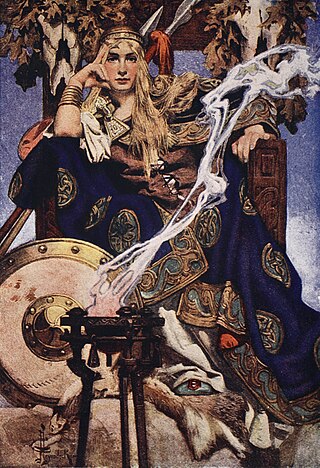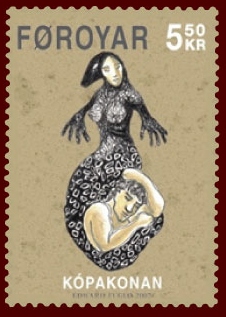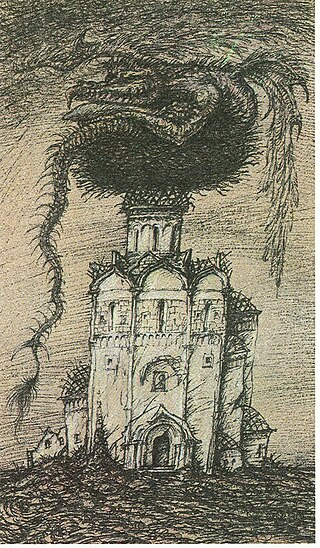Related Research Articles
Seneca mythology refers to the mythology of the Onödowáʼga:, one of the six nations of the Haudenosaunee from the northeastern United States and Canada.

Medb, later spelled Meadhbh, Méabh(a) and Méibh, and often anglicised as Maeve, is queen of Connacht in the Ulster Cycle of Irish mythology. Her husband in the core stories of the cycle is Ailill mac Máta, although she had several husbands before him who were also kings of Connacht. She rules from Cruachan. She is the enemy of Conchobar mac Nessa, king of Ulster, and is best known for starting the Táin Bó Cúailnge to steal Ulster's prize stud bull Donn Cúailnge.

In mythology, folklore and speculative fiction, shape-shifting is the ability to physically transform oneself through unnatural means. The idea of shape-shifting is in the oldest forms of totemism and shamanism, as well as the oldest existent literature and epic poems such as the Epic of Gilgamesh and the Iliad. The concept remains a common literary device in modern fantasy, children's literature and popular culture.

Selkies are mythological creatures that can shapeshift between seal and human forms by removing or putting on their seal skin. They feature prominently in the oral traditions and mythology of various cultures, especially those of Celtic and Norse origin. The term “selkie” derives from the Scots word for “seal”, and is also spelled as silkies, sylkies, or selchies. Selkies are sometimes referred to as selkie folk, meaning 'seal folk'. Selkies are mainly associated with the Northern Isles of Scotland, where they are said to live as seals in the sea but shed their skin to become human on land.

Princess and dragon is an archetypical premise common to many legends, fairy tales, and chivalric romances. Northrop Frye identified it as a central form of the quest romance.

A Slavic dragon is any dragon in Slavic mythology, including the Russian zmei, Ukrainian zmiy, and its counterparts in other Slavic cultures: the Bulgarian zmey, the Slovak drak and šarkan, Czech drak, Polish żmij, the Serbo-Croatian zmaj, the Macedonian zmej (змеј) and the Slovene zmaj. The Romanian zmeu could also be deemed a "Slavic" dragon, but a non-cognate etymology has been proposed.

Dragons, or worms, are present in Germanic mythology and wider folklore, where they are often portrayed as large venomous serpents. Especially in later tales, however, they share many common features with other dragons in European mythology.

The swan maiden is a mythical creature who shapeshifts from human form to swan form. The key to the transformation is usually a swan skin, or a garment with swan feathers attached. In folktales of this type, the male character spies the maiden, typically by some body of water, then snatches away the feather garment, which prevents her from flying away, forcing her to become his wife.

Brazilian mythology is the subset of Brazilian folklore with cultural elements of diverse origin found in Brazil, comprising folk tales, traditions, characters and beliefs regarding places, people, and entities. The category was originally restricted to indigenous elements, but has been extended to include:
The Story of Zoulvisia is an Armenian fairy tale published in Hamov-Hotov, a collection of Armenian fairy tales by ethnologue and clergyman Karekin Servantsians published in 1884. Andrew Lang included it in The Olive Fairy Book. The story was also featured in the book Once Long Ago, by Roger Lancelyn Green and illustrated by Vojtech Kubasta.

Eglė the Queen of Serpents, alternatively Eglė the Queen of Grass Snakes, is a Lithuanian folk tale, first published by M. Jasewicz in 1837.

Incest is found in folklore and mythology in many countries and cultures in the world.

Vagina dentata describes a folk tale in which a woman's vagina is said to contain teeth, with the associated implication that sexual intercourse might result in injury, emasculation, or castration for the man involved. The topic of "vagina dentata" may also cover a rare medical condition affecting the vagina, in which case it is more accurately termed a vaginal dermoid cyst.

Shahmaran is a mythical creature, half-woman and half-snake, originating in the Armenian, Indo-Iranian and Turkic folklores.
Tulisa, the Wood-Cutter's Daughter is an Indian legend published as an annex to Somadeva Bhaṭṭa's work, related to Cupid and Psyche.
Annie Christmas or flatboat Annie is a character in the folklore and tall tales of Louisiana, described as a 7 feet (2.1 m) tall, supernaturally strong African-American woman keelboat captain. She has been described as a female counterpart of the John Henry character, another supernaturally strong African American folklore character. Like John Henry, the character may have been based on a real person. Stories of Annie Christmas have been included in several collections of folktales from the Southern United States.

King Lindworm or Prince Lindworm is a Danish fairy tale published in the 19th century by Danish folklorist Svend Grundtvig.
Monyohe is a character that appears in folktales from the Sotho people. He sometimes is depicted as a serpentine or snake being with invisible powers that marries a human woman.
The Ruby Prince is a South Asian folktale, first published in the late 19th century by author Flora Annie Steel. The tale is a local form of the cycle of the Animal as Bridegroom or The Search for the Lost Husband, in that a woman marries a man of supernatural origin, loses him and must regain him.
Champavati is an Assamese folk tale. It was first collected in the compilation of Assamese folklore titled Burhi Aair Sadhu, by poet Lakshminath Bezbaroa. According to scholar Praphulladatta Goswami, the tale is "current in North Lakhimpur".
References
- 1 2 Charles Godfrey Leland (2020). Algonquin Legends of New England. Library of Alexandria. ISBN 9781465505033 . Retrieved May 23, 2023.
- ↑ Gilbert Livingston Wilson (1916). "The Fourteenth Tale:Glooskap and Atosis". Indian Hero Tales. American Book Company. pp. 115–121. ISBN 9781974134830 . Retrieved May 23, 2023.
- 1 2 Christopher Packard (2021). Mythical Creatures of Maine: Fantastic Beasts from Legend and Folklore. Camden, Maine: Down East Books. pp. 51–56, 168. ISBN 9781608937271 . Retrieved May 14, 2023.